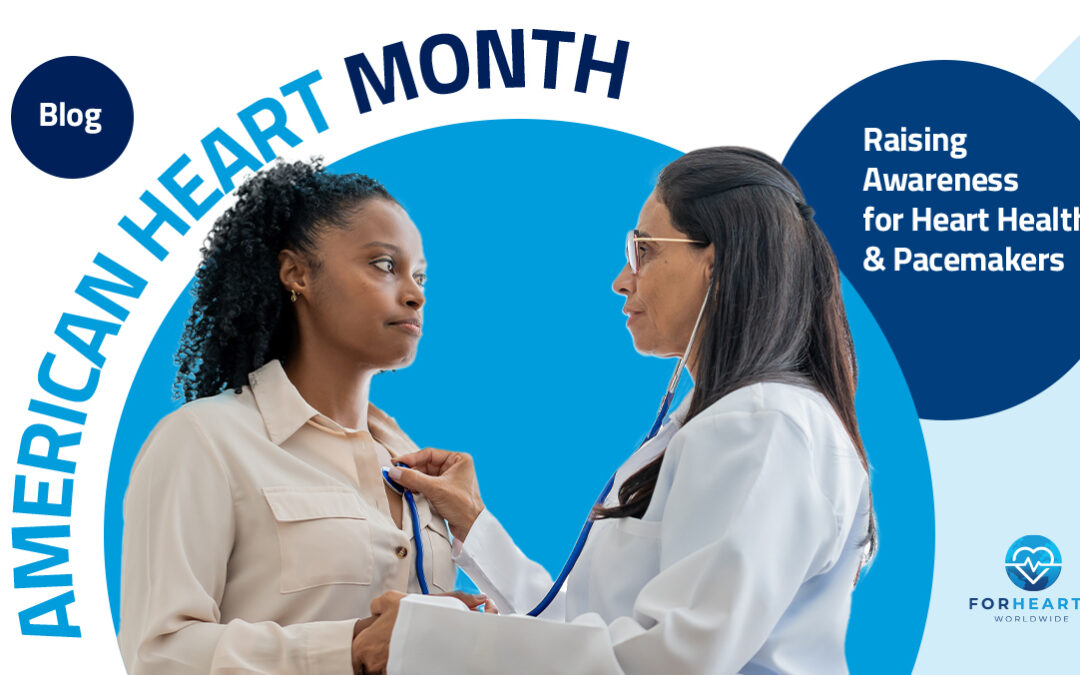February is American Heart Month, recognized annually since 1964 with the goal of raising awareness of heart health, educating Americans to know the warning signs of a cardiac event and motivating them to adopt healthy lifestyles that can help prevent cardiovascular disease and a life threatening cardiac event—the leading cause of death across the globe.
Cardiovascular disease is not just a health issue for the United States. Nearly one-third of all deaths worldwide are due to cardiovascular conditions and diseases—that’s nearly 18.6 million deaths, with more than 75% of these deaths occurring in low- and middle-income countries, according to the World Heart Federation.
At ForHearts Worldwide, we celebrate American Heart Month on a global scale every day through our mission to provide life-saving pacemakers to those with heart rhythm conditions in underserved countries. See how the latest innovations in pacemaker technology from our device manufacturer partners are helping ForHearts heal hearts worldwide.
The Importance of Pacemakers for Heart Rhythm Disorders
In 2023, a significant number of implants took place worldwide The most common reason for a pacemaker is arrhythmia, meaning the heart has an abnormal rhythm—it can beat too quickly, too slowly, or with an irregular rhythm. A pacemaker can also help a weak heart to beat “in sync,” which can occur in people who may have:
- Congenital heart defects
- Enlarged heart muscles
- Previous Heart attacks
- A Heart transplant
- Or Heart failure
No matter the underlying cause or issue, ForHearts Worldwide is committed to providing the needed pacing device to hearts in need, believing that a patient’s lack of access or resources should never stand in the way of lifesaving care.
Our ability to provide pacemaker devices, monitor those devices with lifelong follow-up care at no cost to our patients would not be possible without the device manufacturers who partner with us. We are proud to count Abbott among our partners who are providing their leading cardiac rhythm management devices to patients in need.
Saving Lives with New Innovations in Pacemaker Technology
Over the last year, Abbott and other companies have developed new technologies, advancing the field of cardiac pacing and patient monitoring with some of the most innovative devices ever available.
In July 2023, Abbott received FDA approval for their new AVEIR dual chamber leadless pacemaker, the first of its kind in the world. Unlike traditional heart pacing devices that requires threading wires (called leads) through a vein to the heart and then connecting them to a pacemaker implanted under the skin, Abbott’s AVEIR leadless system consists of two tiny pacemakers (smaller than a AAA battery) that normalize heart rhythm wirelessly.
These small pacemakers are inserted via a catheter into a vein and guided via X-ray (so no incision is needed) to be placed within the upper and lower chambers of the heart. They then “connect” via Abbott’s proprietary i2i communication technology, which “utilizes high-frequency pulses to relay messages via the naturally conductive characteristics of the body’s blood between each leadless pacemaker,” creating “beat-to-beat communication” between the two pacemakers and the heart.
“A very clever and energy-efficient innovation,” says Cardiac Electrophysiologist Cyrus Hadadi, MD, associate director of Cardiac Arrhythmia Research at MedStar Washington Hospital Center. In November 2023, the AVEIR dual-chamber leadless pacemaker was implanted in two patients by Dr. Hadad’s team at MedStar Washington, one of the first hospitals in the country to offer Abbott’s new pacemaker technology.
“Leadless pacemakers have been limited to a single chamber device because seamless, wireless synchronization of two pacemakers has been an insurmountable engineering challenge – until now!” says Randel Woodgrift, senior vice president of Abbott’s cardiac rhythm management business.
This “conductive communication” requires less battery current than other wireless options, such as inductive, radio frequency or Bluetooth communication, for a longer device lifespan. Additionally, this leadless pacemaker system reduces a patient’s potential for complications due to lead issues, with its minimally invasive implant procedure giving patients a shorter recovery period.
Typically, magnetic Resonance Imaging (MRI) scans can disrupt a pacemaker’s function and potentially damage the device, necessitating additional surgery for repair or even replacement. Therefore, patients with pacemakers and their medical providers must take additional precautions for an MRI. This usually means a pre- and post-scan programming visit to ensure the device is still functioning properly. However, the Magnetic Resonance detection sensors in the Amvia Edge detect MRI fields to automatically switch the device into MRI mode before the scan and resetting it after, so no extra pre- and post-scan appointments are needed.
These latest innovations in pacemaker technology are healing hearts in America and beyond. Your support can help ensure these kinds of pacemaker technologies and cardiovascular procedures are available to more hearts in need where ForHearts works. Help us by making your donation to ForHearts Worldwide in honor of American Heart Month.

